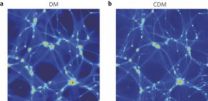(Press-News.org) Consumption was one of the worst known diseases of the 18th century. Thanks to medical advances, the number of deaths from this lung disease – which is today known as tuberculosis – has declined significantly. Efforts to eradicate the disease in the 1950s and 1960s resulted in a wide range of new drugs entering the market.
And yet 1.4 million people still continue to die each year from tuberculosis. Multidrug-resistant strains of the disease-causing pathogen are especially dangerous because they can no longer be treated with today's drugs (see box). "In the past 50 years, only one new tuberculosis drug has come on to the market, and that was in 2012," says Karl-Heinz Altmann, Professor of Pharmaceutical Biology at ETH Zurich. New active substances that are able to kill multidrug-resistant strains of the disease are therefore urgently needed. Altmann and his team have now laid the foundation for new tuberculosis drugs, and they were inspired by a bacteria-derived antibiotic called pyridomycin.
New design for greater efficacy
Pyridomycin inhibits the growth of the tuberculosis pathogen Mycobacterium tuberculosis, but it is degraded relatively quickly and is therefore ineffective. However, by using the structure of pyridomycin, Altmann and his research group have designed a molecule that has several advantages over the natural active substance. The new molecule is more stable and is easier to produce synthetically; it can also serve as a lead structure for the synthesis and biological testing of further modified versions of the active substance. Drugs could eventually be developed that work efficiently and are well tolerated. They could also be be adapted such as to overcome new drug-resistant strains of the tuberculosis pathogen. The researchers have applied for a patent for the new active substance's basic structure and the method of production.
The researchers found inspiration from a long forgotten substance. In 1953, Japanese scientists discovered that pyridomycin inhibits the growth of the tuberculosis pathogen Mycobacterium tuberculosis. But the compound was not investigated further for decades thereafter. "Everyone behaved as though the tuberculosis problem was solved," says Altmann. While researching the literature, he came across the pyridomycin and worked together with a research team led by Stewart Cole, a professor of microbial pathogenesis at EPFL, to decode how it works. It paralyses an important component of cellular metabolism, which is essential for building the cell wall of the tuberculosis pathogen. Although an available drug called isoniazid targets the same key protein , it must first be converted inside the tuberculosis bacteria into the actual inhibitor. Pyridomycin, in contrast, binds directly to the target protein and therefore circumvents pre-existing resistance mechanisms that prevent isoniazid from becoming activated. The new approach of the active substance enables a wide variety of structures for new drugs against tuberculosis.
INFORMATION:
[Box:] Tuberculosis resistance
Drug-resistant tuberculosis develops due to the lengthy therapy that tuberculosis patients must go through. They should take their medication for six months, but as the symptoms and discomfort usually disappear after the first few weeks patients frequently stop the therapy much too early. The result is that the pathogens remain in the body, adapt to the drugs and become resistant.
Literature references
Hartkoorn RC, Pojer F, Read JA, Gingell H, Neres J, Horlacher OP, Altmann KH: Pyridomycin bridges the NADH- and substrate-binding pockets of the enoyl reductase InhA. Nature Chemical Biology, 1 December 2013, doi: 10.1038/nchembio.1405
Horlacher OP, Hartkoorn RC, Cole ST, Altmann KH: Synthesis and antimycobacterial activity of 2,1'-dihydropyridomycins. ACS Med Chem Letters, 18 December 2012, doi: 10.1021/ml300385q
Licensing Opportunity: Novel synthetic scaffold for anti tuberculosis drugs http://www.switt.ch/adminall2/userfiles/technologien/571_novel_synthetic_scaffold_for_anti_tuberculosis_drugs_2012_077.pdf
New approach for tuberculosis drugs
2014-07-02
ELSE PRESS RELEASES FROM THIS DATE:
Foodborne bacteria not as harmless to chickens as previously thought
2014-07-02
Foodborne pathogen Campylobacter jejuni, which results in more than 300,000 cases of food poisoning each year in England and Wales, had previously not been considered to cause disease in chickens and the bacteria were thought to be part of the normal microbe environment of the birds.
Reader in Foodborne Zoonoses, Dr Paul Wigley, explains: "Our findings change the way we view the biology of this bacterial infection. It can cause problems in the gut, as it does in humans, but when the chickens walk through the wet excrement left in their bedding it can damage their feet ...
Fine-scale climate model projections predict malaria at local levels
2014-07-02
Fine-scale climate model projections suggest the possibility that population centers in cool, highland regions of East Africa could be more vulnerable to malaria than previously thought, while population centers in hot, lowland areas could be less vulnerable, according to a team of researchers. The team applied a statistical technique to conventional, coarse-scale climate models to better predict malaria dynamics at local levels.
"People might have an interest in predictions for global malaria trends and even more so for regional patterns, but they probably care most ...
Food allergies: A new, simple method to track down allergens
2014-07-02
Although food allergies are common, sufferers often don't know exactly what in foods cause their allergic reactions. This knowledge could help develop customized therapies, like training the body's immune system to respond to certain proteins found in foods. However, determining which protein in a food causes an allergic response to a patient requires time-consuming tests that often ignore rare or unexpected allergens. Publishing in Analytical Chemistry, EPFL scientists have developed a highly-sensitive method that can quickly and accurately identify the culprit proteins ...
Socioeconomic status associated with peripheral artery disease risk
2014-07-02
Previous research has established a link between lower socioeconomic status and an increased risk of cardiovascular disease. In a new study led by Brigham and Women's Hospital (BWH), researchers have found that there are also higher rates of peripheral artery disease (PAD) in individuals with low income and lower attained education levels in the United States.
These findings are published online ahead of print in Circulation: Cardiovascular Quality and Outcomes.
"Our finding highlights the need to focus on education and advocacy efforts for these at-risk populations," ...
Reinterpreting dark matter
2014-07-02
This news release is available in Spanish.
In cosmology, cold dark matter is a form of matter the particles of which move slowly in comparison with light, and interact weakly with electromagnetic radiation. It is estimated that only a minute fraction of the matter in the Universe is baryonic matter, which forms stars, planets and living organisms. The rest, comprising over 80%, is dark matter and energy.
The theory of cold dark matter helps to explain how the universe evolved from its initial state to the current distribution of galaxies and clusters, the structure ...
Weekend emergency surgeries deadlier for children
2014-07-02
Children who undergo simple emergency surgeries, such as hernia repairs or appendix removals, on weekends are more likely to suffer complications and even die than children getting the same kind of treatment during the week, according to results of a Johns Hopkins Children's Center study.
The Johns Hopkins team says that although the number of deaths was small, the marked difference in death and risk of other complications points to a worrisome "weekend effect" observed across hospitals nationwide that calls for an in-depth examination of possible after-hours safety lapses ...
One in six adolescents in the ER has experienced dating violence
2014-07-02
WASHINGTON — Of adolescents visiting the emergency department for any reason, one in five girls and one in eight boys reported dating violence in the past year. According to a study published online Monday in Annals of Emergency Medicine, dating violence among adolescents was also strongly associated with alcohol, illicit drug use and depression ("Dating Violence Among Male and Female Youth Seeking Emergency Department Care") http://tinyurl.com/oakk4aq.
"An enormous number of youth and adolescents have already experienced violence in their dating lives," said lead ...
A stellar womb shaped and destroyed by its ungrateful offspring
2014-07-02
This image was taken as part of the ESO Cosmic Gems programme [1] using the Wide Field Imager on the MPG/ESO 2.2-metre telescope at the La Silla Observatory in Chile. It shows Gum 15, located in the constellation of Vela (The Sails), some 3000 light-years from Earth [2]. This glowing cloud is a striking example of an HII region [3]. Such clouds form some of the most spectacular astronomical objects we can see; for example the Eagle Nebula (which includes the feature nicknamed "The Pillars of Creation"), the great Orion Nebula , and this less famous example, Gum 15.
Hydrogen ...
'Deep learning' makes search for exotic particles easier
2014-07-02
Irvine, Calif. — Fully automated "deep learning" by computers greatly improves the odds of discovering particles such as the Higgs boson, beating even veteran physicists' abilities, according to findings by UC Irvine researchers published today in the journal Nature Communications.
"We are thrilled with the publication of our work," said co-author Pierre Baldi, Chancellor's Professor of computer science, "and even more so with the hope that deep learning may help solve fundamental open questions about the nature of matter, gravity and the origin of the universe."
Baldi, ...
Superconducting-silicon qubits
2014-07-02
Theorists propose a way to make superconducting quantum devices such as Josephson junctions and qubits, atom-by-atom, inside a silicon crystal. Such systems could combine the most promising aspects of silicon spin qubits with the flexibility of superconducting circuits. The researcher's results have now been published in Nature Communications (1).
High quality silicon is one of the historical foundations of modern computing. But it is also promising for quantum information technology. In particular, electron and nuclear spins in pure silicon crystals have been measured ...


